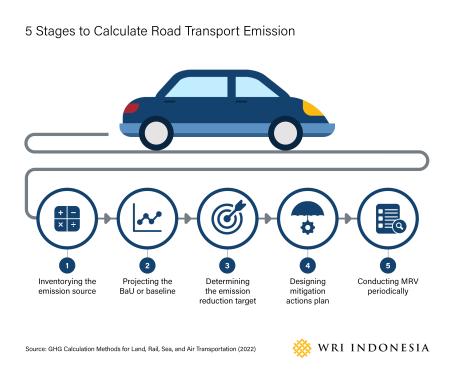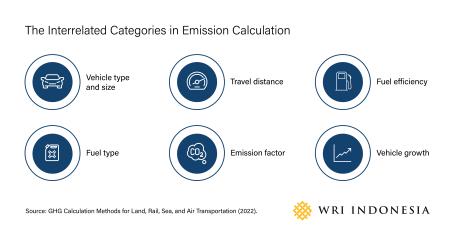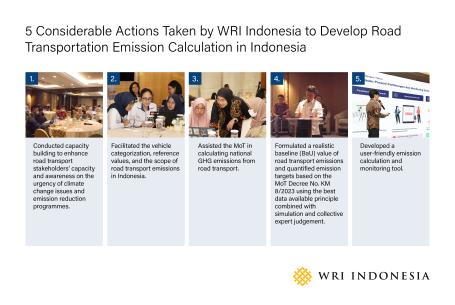Indonesia’s Path to Net-Zero Emission: Measuring Road Transport Emissions as the Foundation for a Sustainable Transport Policy
This article is currently only available in English
Like many developing countries in the world, Indonesia’s economic growth has progressed hand in hand with the surge in transport demand. Efforts to prevent the extreme impact of climate change have encountered challenges in low-carbon transition in the energy and transport sectors in Indonesia as the majority of vehicles today run on fossil fuel, which is the source of CO2 emissions. The energy and transport sectors have been struggling to decouple growth from carbon emissions for many decades.
Theoretically speaking, reducing energy consumption in road transport would depend on the combination of efficient land-use policy, minimizing trips, and providing options for low-carbon mobility, such as walking, cycling, and public transit. This is not an easy feat, especially when we look at the statistics of road transport in Indonesia. First, motorized vehicle sales are growing at an alarming average rate of 8.3% per month, this can be attributed to better economic conditions which lead to higher purchasing power to own a vehicle. It is worth noting that a higher proportion of the total registered vehicles are two-wheelers, this may result in a higher rate of traffic accidents and fatalities. Second, many cities have a low public transport modal share (2- 5%), many of which are not mass transport, with the exception of Jakarta (10%).
Road transport consumes approximately 90% of the total energy used by the transport sector, which in turn has made this sub-sector the biggest emitter in the transport sector. Given that the transport sector is considered to be the top three contributors to energy sector emissions, contributing 27% of the total greenhouse gas (GHG), efforts to transform road transport to be compatible with the net-zero vision is a compelling challenge and Indonesia should equip itself with strong policies to achieve the vision.
Recognizing the immense challenge, the Government has placed a priority on enhancing the quality of mobility. This initiative aims to not only move people and goods efficiently, but also deliver additional benefits, such as cleaner air, healthier communities, and better cities. Given the interconnected nature of the transport system, pushing for a change in transport would generate positive results within and across other sectors, such as energy and land use.
What can we do to prepare a transport policy that would guide us to a net zero future? This is where the emission inventory can play a role.
Emission inventory plays a vital role in enabling the road transport sub-sector to quantify emissions, this would assist road transport policymakers in formulating effective and concrete policy measures. To address the lack of formal and standardized regulations on calculating emissions from the transport sector in Indonesia, WRI Indonesia is committed to supporting the development of an emission inventory framework on the road transport sub-sector, funded by the UK PACT Future Cities Program. A critical step to start the process is developing a consensus about vehicle categories and the value of parameters to determine road transport emissions, such as fuel efficiency, emissions factors, and travel distance. Understanding the relationship between these variables will be the foundation for emissions reduction targets.
Indonesia’s Role in Curbing Emissions to Accelerate Sustainable Development
As a populous country with 278 million inhabitants, Indonesia stands at the forefront of global emissions reduction efforts. Indonesia acknowledges the importance of sustainable transport in achieving the 2030 Agenda for Sustainable Development and the Paris Climate Change Agreement. Indonesia has signed the Paris Agreement to limit the rising global temperature to 1.5°C above pre-industrial levels through an ambitious carbon emissions reduction target stipulated in its National Determined Contribution (NDC).
The rapid growth in the urban population has increased urban mobility. Many Indonesian cities offer limited public transport options, this has resulted in a higher usage of private motorized vehicles. The surge of motorized vehicles over the past decade has driven Indonesia to revise its emission reduction targets, outlined in its Enhanced NDC, i.e. from 29% to 31.89% without international support and 41% to 43.20% with international support by 2030. According to the Ministry of Energy and Mineral Resources, Indonesia’s Net-Zero Emission (NZE) Roadmap for the Energy Sector 2060 mandates that the transport sector emission levels in 2060 should not exceed 52 million tons of CO2.
In line with the ambitious targets set in the NDC, the transport sector is expected to carry out mitigation actions pertaining to climate change. The mitigation actions for the transport sector are stipulated in the Minister of Transport Decree No. KM 8/2023 concerning the Determination of Climate Change Mitigation Actions within the Transport Sector to Achieve the NDC Target. The document covers various mitigation action policies, such as road-based urban public transport development, utilizing ATCS (Area Traffic Control System), TOD (Transit Oriented Development), NMT (Non-Motorized Transport) development, promoting electric motorized vehicles (commonly referred to as KBLBB in Indonesia) and charging station facilities, implementing Electronic Road Pricing (ERP), etc.
Robust data, calculations, and standardized guidelines are needed to quantify the road transport emission reduction achieved through mitigation actions in NZE scenarios. The current calculation, which merely relies on fuel consumption data, does not sufficiently provide a comprehensive overview of the road transport sub-sector since it does not incorporate travel activities and emission sources.
Road Transport Emission Calculation and Its Current Challenges
In general, the road transport emission calculation method comprises a series of processes, starting with the inventory of the emission source, Business as Usual (BaU) or baseline projection, determining the emission reduction targets, designing mitigation action plans, and conducting Monitoring, Reporting, and Verification (MRV) periodically.

The emission inventory refers to a series of emission calculations consisting of the types of emission and source of emissions in a particular location and time period, and the use of an accurate emission calculation methodology. With the emission inventory, policymakers will be able to determine the level of emission reductions, discover emission sources, and target regulatory actions, as well as monitor progress by calculating the emissions.
However, the situation becomes complicated since every vehicle produces a distinct number of emissions due to differences in emission parameters, such as vehicle type and size, distance traveled, fuel efficiency, and type of fuel used, all of which are factors that influence the emission factor.

Additionally, the availability of detailed data and relevant information for the above-mentioned parameters is severely limited. The international best practices recommend firstly categorizing the vehicle type and determining the local (Indonesia) default or reference parameter values for each type of vehicle category, including the emission factor, prior to moving on to the next step of calculating road transport emissions.
Why do we need vehicle categorization and reference values? How can the data be used to create a more sustainable transport policy for Indonesia?
The road transport emission inventory and the baseline of Indonesia's road transport have never been officially established. The emission inventory is a fundamental step toward the sustainable transport system pathway because the data produced will provide insights for decision-making, guide policy design and evaluation, progress monitoring, and foster innovations. Therefore, determining local emission factor values, as well as setting up vehicle categorization and other emission parameters, is crucial as a primary phase towards establishing the emission inventory.
Furthermore, the national road transport emission count for Indonesia must conform to international accounting standards. By aligning these standards, the resulting emissions data will gain global recognition, allowing for effective benchmarking, and tracking progress on a national and international scale. WRI Indonesia, under the UK PACT Future Cities Programme, has taken several actions as illustrated in the following figure.

WRI Indonesia held a seminar and an event discussing the technical guidelines for climate change mitigation actions in road transport. The event aimed to enhance the capacity of MoT staff and support them in utilizing the emission calculation and monitoring tool. The road transport emission calculation tool was handed over to the MoT during the event. The tool was developed to support policymakers in formulating measurable, science- and data-based actions to decarbonize the transport sector. Moreover, the event also discussed the national GHG reduction target, through presentations and discussions referring to the MoT Decree No. KM 8/2023. The discussions were focused on the strategies and collaboration between the central and local government for the development of Bus Rapid Transit (BRT) and the adoption of Baterry-based Electric Vehicles (KBLBB), by involving the Ministry of Energy and Mineral Resources and the Coordinating Ministry for Maritime Affairs and Investment as resource persons.
What’s next?
After the five considerable actions mentioned above have been performed, the relevant parties need to reach an agreement on the results, especially the vehicle category and road transport emission parameters, through an institutional means, e.g., a ministerial circular letter or ministerial decree. Such legal products are imperative to ensure a consistent and objective emission calculation standard, at the national and regional levels. By doing so, emission reduction strategies, in the form of corrective actions stipulated in transport policies can be performed effectively.
Furthermore, efforts to properly carry out climate change mitigation actions in the road transport sub-sector would not be possible without collaboration between actors, i.e. the national government (MoT and other relevant ministries, such as the Ministry of Energy and Mineral Resources, Ministry of Environment and Forestry, and others), subnational government, road transport operators, and respective organizations. The collaborative actions enable the synchronization of efforts to achieve emissions reduction targets, as well as foster an integrated approach that could set the target for developing sustainable transport alternatives that are aligned with national goals and international commitments.
A formal recognition that describes the robust emission inventory framework and operational guideline is expected. This is done by ensuring that the data collected is obtained using a measurable and well-formulated process (e.g., a unified local emission factor within Indonesia), conforming to international standards, and complemented by cross-sector support from relevant ministries and other actors. This approach showcases Indonesia’s commitment to addressing the adverse impacts of climate change and fosters the formulation of high-impact policies and measures to achieve emissions reduction targets in the road transport sub-sector. These measures are necessary to ensure the sustainability of the overall transport emissions climate mitigation actions, hence enabling the pursuit of sustainable transport policies in Indonesia.
About UK PACT Future Cities
UK Partnering for Accelerated Climate Transitions (PACT) is a jointly governed and funded programme by the UK Government's Foreign, Commonwealth and Development Office (FCDO) and the Department for Energy Security and Net Zero (DESNZ) through the UK's International Climate Finance. In Indonesia, it works in partnership with the Ministry of Transport (MoT) through the Future Cities Programme to enhance metropolitan cities' transport policies with ambitious parameters to increase people's safety, lower road emissions, better access, and inclusiveness, and enhance resilience against climate change impacts.